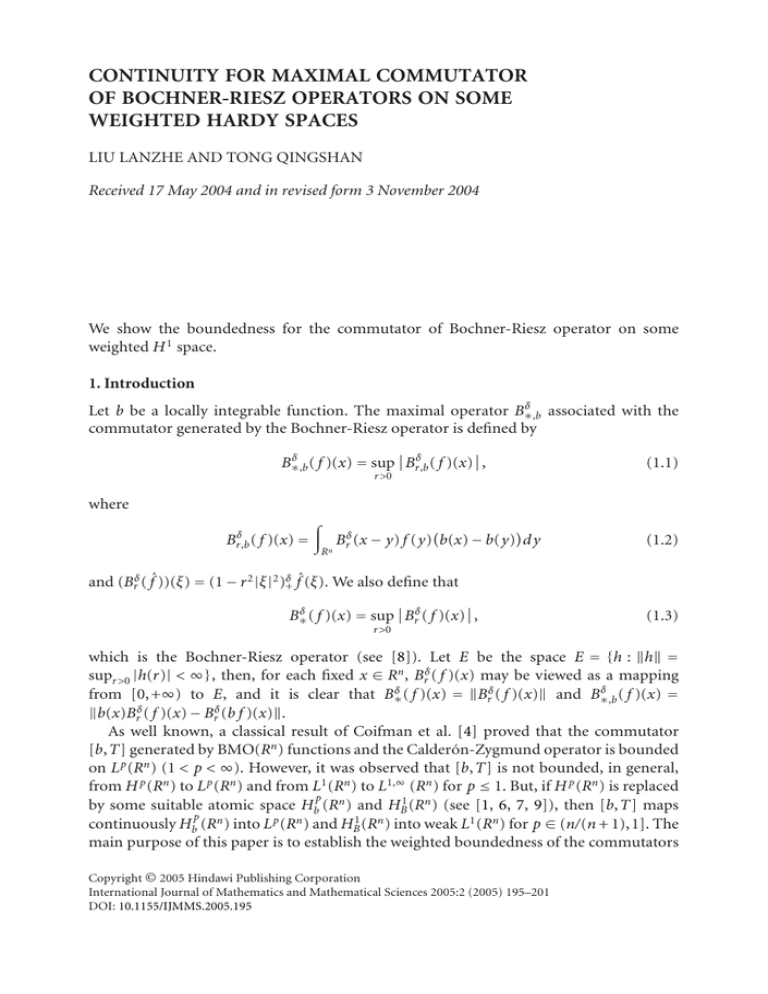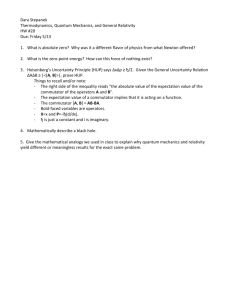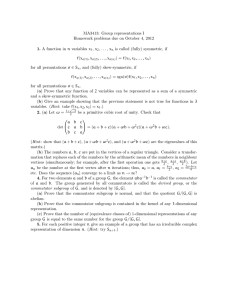CONTINUITY FOR MAXIMAL COMMUTATOR OF BOCHNER-RIESZ OPERATORS ON SOME WEIGHTED HARDY SPACES
advertisement

CONTINUITY FOR MAXIMAL COMMUTATOR
OF BOCHNER-RIESZ OPERATORS ON SOME
WEIGHTED HARDY SPACES
LIU LANZHE AND TONG QINGSHAN
Received 17 May 2004 and in revised form 3 November 2004
We show the boundedness for the commutator of Bochner-Riesz operator on some
weighted H 1 space.
1. Introduction
Let b be a locally integrable function. The maximal operator B∗δ ,b associated with the
commutator generated by the Bochner-Riesz operator is defined by
δ
B∗δ ,b ( f )(x) = sup Br,b
( f )(x),
(1.1)
r>0
where
δ
Br,b
( f )(x) =
Rn
Brδ (x − y) f (y) b(x) − b(y) d y
(1.2)
and (Brδ ( fˆ ))(ξ) = (1 − r 2 |ξ |2 )δ+ fˆ (ξ). We also define that
B∗δ ( f )(x) = sup Brδ ( f )(x),
(1.3)
r>0
which is the Bochner-Riesz operator (see [8]). Let E be the space E = {h : h =
supr>0 |h(r)| < ∞}, then, for each fixed x ∈ Rn , Brδ ( f )(x) may be viewed as a mapping
from [0,+∞) to E, and it is clear that B∗δ ( f )(x) = Brδ ( f )(x) and B∗δ ,b ( f )(x) =
b(x)Brδ ( f )(x) − Brδ (b f )(x).
As well known, a classical result of Coifman et al. [4] proved that the commutator
[b,T] generated by BMO(Rn ) functions and the Calderón-Zygmund operator is bounded
on L p (Rn ) (1 < p < ∞). However, it was observed that [b,T] is not bounded, in general,
from H p (Rn ) to L p (Rn ) and from L1 (Rn ) to L1,∞ (Rn ) for p ≤ 1. But, if H p (Rn ) is replaced
p
by some suitable atomic space Hb (Rn ) and HB1 (Rn ) (see [1, 6, 7, 9]), then [b,T] maps
p n
p
n
continuously Hb (R ) into L (R ) and HB1 (Rn ) into weak L1 (Rn ) for p ∈ (n/(n + 1),1]. The
main purpose of this paper is to establish the weighted boundedness of the commutators
Copyright © 2005 Hindawi Publishing Corporation
International Journal of Mathematics and Mathematical Sciences 2005:2 (2005) 195–201
DOI: 10.1155/IJMMS.2005.195
196
Maximal commutator of Bochner-Riesz operator
related to Bochner-Riesz operator and BMO(Rn ) function on some weighted H 1 space.
We first introduce some definitions (see [1, 6, 7, 9]).
Definition 1.1. Let b, w be locally integrable functions and w ∈ A1 (i.e., Mw(x) ≤ cw(x)
a.e.). A bounded measurable function a on Rn is said to be (w,b)-atom if
(i) suppa ⊂ B = B(x0 ,r),
−1
,
(ii) aL∞ ≤ w(B)
(iii) a(y)d y = a(y)b(y)d y = 0.
A temperate distribution f is said to belong to Hb1 (w) if, in the Schwartz distributional
sense, it can be written as
f (x) =
∞
λ j a j (x),
(1.4)
j =1
where a j ’s are (w,b)-atoms, λ j ∈ C, and
∞
j =1 |λ j | < ∞.
Moreover, f Hb1 (w) ∼
∞
j =1 |λ j |.
Definition 1.2. Let w ∈ A1 . A function f is said to belong to weighted Block H 1 space
as (1.4), where a j ’s are w-atoms (i.e., a j ’s satisfy Definition
HB1 (w) if f can be written
1.1(i), (ii), and (iii) a(y)d y = 0) and λ j ∈ C with
∞
λ j 1 + log+ 1 < ∞.
λ j (1.5)
j =1
Moreover, f HB1 (w) ∼
∞
+ j =1 |λ j |(1 + log (( i |λi |)/ |λ j |)).
Now, we formulate our results as follows.
Theorem 1.3. Let b ∈ BMO(Rn ) and w ∈ A1 . Then the maximal commutator B∗δ ,b is
bounded from Hb1 (w) to L1w (Rn ) when δ > (n − 1)/2.
Theorem 1.4. Let b ∈ BMO(Rn ) and w ∈ A1 . Then the maximal commutator B∗δ ,b is
∞
n
bounded from HB1 (w) to L1,
w (R ) when δ > (n − 1)/2.
Theorem 1.5. Let b ∈ BMO(Rn ) and w ∈ A1 . Then the maximal commutator B∗δ ,b is
∞
n
bounded from H 1 (w) to L1,
w (R ) when δ > (n − 1)/2.
2. Proof of theorems
Proof of Theorem 1.3. It suffices to show that there exists a constant C > 0 such that for
every (w,b)-atom a,
δ
B (a)
1 ≤ C.
∗,b
Lw
(2.1)
Let a be a (w,b)-atom supported on a ball B = B(x0 ,R). We write
Rn
B∗δ ,b (a)(x) w(x)dx
=
|x−x0 |≤2R
B∗δ ,b (a)(x) w(x)dx +
|x−x0 |>2R
B∗δ ,b (a)(x) w(x)dx ≡ I + II.
(2.2)
L. Lanzhe and T. Qingshan 197
For I, taking q > 1, by Hölder’s inequality and the Lq -boundedness of B∗δ ,b (see [2]), we
see that
I ≤ C B∗δ ,b (a)
Lwq · w(2B)1−1/q ≤ C aLwq w(B)1−1/q ≤ C.
For II, let b0 = |B(x0 ,R)|−1
II ≤
B(x0 ,R) b(y)d y,
∞ k+1
k
k=1 2 R≥|x−x0 |>2 R
+
(2.3)
then
b(x) − b0 B δ (a)(x)w(x)dx
∗
∞ δ
k+1
k
k=1 2 R≥|x−x0 |>2 R
(2.4)
B∗ b − b0 a (x)w(x)dx = II1 + II2 .
For II1 , we choose δ0 such that
n+1
n−1
< δ0 < min δ,
2
2
(2.5)
and consider the following two cases.
Case 1 (0 < r ≤ R). In this case, note that (see [8])
δ B (z) ≤ C 1 + |z| −(δ+(n+1)/2) ,
(2.6)
we have, for |x − x0 | > 2| y − x0 |,
a(y)
δ+(n+1)/2 d y
B(x0 ,R) 1 + |x − y |/r
−(δ0 +(n+1)/2)/n
≤ C |B |(δ0 +(n+1)/2)/n 2k+1 B w(B)−1 .
δ
B (a)(x) ≤ Cr −n
r
(2.7)
Case 2 (r > R). In this case, note that
β δ ∇ B (z) ≤ C 1 + |z| −(δ+(n+1)/2)
(2.8)
for any β = (β1 ,...,βn ) ∈ (N ∪ {0})n and |x − x0 | > 2| y − x0 |, where
∂
∇ =
∂x1
β
β1
∂
···
∂xn
βn
,
(2.9)
by the vanishing condition of a, we gain
a(y) y − x0 δ+(n+1)/2 d y
B(x0 ,R) 1 + x − x0 /r
−(δ0 +(n+1)/2)/n
≤ C |B |(δ0 +(n+1)/2)/n 2k+1 B w(B)−1 .
δ
B (a)(x) ≤ Cr −(n+1)
r
(2.10)
198
Maximal commutator of Bochner-Riesz operator
Combining Case 1 with Case 2, we obtain
II1 ≤ C
∞ 2k+1 R≥|x−x
k =1
≤C
∞
0
|>2k R
b(x) − b0 |B |(δ0 +(n+1)/2)/n
−(δ0 +(n+1)/2)/n
× 2k+1 B w(B)−1 w(x)dx
2−k(δ0 +(n+1)/2) w(B)−1
2k+1 R≥|x−x
k =1
0
|>2k R
(2.11)
b(x) − b0 w(x)dx.
Since w ∈ A1 , w satisfies the reverse of Hölder’s inequality as follows:
1
|B |
1/ p
p
B
w(x) dx
C
≤
|B |
B
w(x)dx
(2.12)
for any ball B and some 1 < p < ∞ (see[10]). Using the properties of BMO(Rn ) functions
(see [10]), and noting w ∈ A1 , then
B w B2
· 1 ≤C
B2 w B1
(2.13)
for all balls B1 , B2 with B1 ⊂ B2 . Thus, by Hölder’s and reverse of Hölder’s inequalities for
w ∈ A1 , we get, for 1/ p + 1/ p = 1,
II1 ≤ C
∞
k =1
2
−k(δ0 +(n+1)/2)
w(B)
1
× 2k+1 B ≤ C bBMO
∞
k2
−1 k+1
2
1/ p
p
2k+1 B
(2.14)
w(x) dx
−k(δ0 −(n−1)/2)
k =1
1/ p
p
1
B k+1 b(x) − b0 dx
2 B 2k+1 B
k w 2 B |B |
2k B w(B) ≤ C.
For II2 , similar to the estimate of II1 , we obtain
−(δ0 +(n+1)/2)
Brδ b − b0 a (x) ≤ C bBMO w(B)−1 |B |(δ0 +(n+1)/2)/n x − x0 ,
(2.15)
thus
II2 ≤ C bBMO
∞
k =1
≤ C bBMO
∞
−(δ0 +(n+1)/2)/n w(B)−1 |B |(δ0 +(n+1)/2)/n 2k B 2
−k(δ0 −(n−1)/2)
k =1
w 2k B
k w 2 B |B |
2k B w(B) ≤ C.
This finishes the proof of Theorem 1.3.
To prove Theorem 1.4, we recall the following lemma (see [5, 10]).
(2.16)
L. Lanzhe and T. Qingshan 199
Lemma 2.1. Let w ≥ 0 and {gk } be a sequence of measurable functions satisfying
g k ∞
L1,
w
≤ 1.
(2.17)
Then, for every numerical sequence {λk },
λk gk k
∞
L1,
w
≤C
λk + log
λj
λk
.
(2.18)
j
k
Proof of Theorem 1.4. By Lemma 2.1, it is enough to show that there exists a constant C
such that
δ
B (a)
1,∞ ≤ C
∗,b
Lw
for each w-atom a.
(2.19)
Let a be a w-atom supported on a ball B = B(x0 ,r). We write
w x ∈ Rn : B∗δ ,b (a)(x) > λ
≤w
x ∈ 2B : B∗δ ,b (a)(x) > λ
+ w x ∈ (2B)c : B∗δ ,b (a)(x) > λ
= I + II.
(2.20)
For I, by the Lq -boundedness of B∗δ ,b for q > 1, we gain
I ≤ λ−1 B∗δ ,b (a)χ2B L1w ≤ Cλ−1 B∗δ ,b (a)
Lwq · w(B)1−1/q
≤ Cλ−1 aLwq · w(B)1−1/q ≤ Cλ−1 .
For II, let b0 = |B |−1
B b(x)dx,
(2.21)
notice that
B∗δ ,b (a)(x) = b(x)Brδ (a)(x) − Brδ (ba)(x)
= b(x) − b0 Brδ (a)(x) − Brδ b − b0 a (x)
≤ b(x) − b0 Brδ (a)(x)
+ Brδ b − b0 a (x)
δ
≤ b(x) − b0 B∗
(a)(x) + B∗δ b − b0 a (x),
(2.22)
we have
II ≤ w
+w
x ∈ (2B)c : b(x) − b0 gµ∗ (a)(x) >
x ∈ (2B)c : gµ∗ b − b0 a (x) >
λ
2
λ
2
(2.23)
= II1 + II2 .
Similar to the proof of Theorem 1.3, we get
II1 ≤ Cλ
−1
= Cλ−1
(2B)c
∗
∞ k =1
II2 ≤ Cλ−1
b(x) − b0 B δ (a)(x)w(x)dx
2k+1 B \2k B
(2B)c
b(x) − b0 B δ (a)(x)w(x)dx ≤ Cλ−1 bBMO ,
∗
B∗δ b − b0 a (x)w(x)dx ≤ Cλ−1 bBMO .
(2.24)
200
Maximal commutator of Bochner-Riesz operator
Combining the estimate of I, II1 , and II2 , we gain
w x ∈ Rn : B∗δ ,b (a)(x) > λ
≤ Cλ−1 bBMO .
(2.25)
This completes the proof of Theorem 1.4.
Proof of Theorem 1.5. . Given f ∈ H 1 (w), let f = j λ j a j be the atomic decomposition
for
f . By a limiting
argument, it suffices to show Theorem 1.5 for a finite sum of f =
Q λQ aQ with
Q |λQ | ≤ C f H 1 (w) . We may assume that each Q (the supporting cube
of aQ ) is dyadic. For λ > 0 by [3, Lemma 4.1], there exists a collection of pairwise disjoint
dyadic cubes {S} such that
λQ ≤ Cλ|S|,
Q⊂S
|S| ≤ λ
−1
−1
λ
|Q| χQ Q
λ Q ,
S
∀S,
Q⊂S
Q
(2.26)
≤ Cλ.
L∞
Let E = S S, where for a fixed cube Q, Q denotes the cube with the same center as
√
Q but with the side-length 4 n times that of Q. Then, |E| ≤ Cλ−1 f H 1 . Set M(x) =
δ
2
S Q⊂S λQ aQ , N(x) = f (x) − M(x). By the L boundedness of B∗,b and the well-known
argument, it suffices to show that
w x ∈ Ec : B∗δ ,b (M)(x) > λ
Because B∗δ ,b (M)(x) ≤
S
δ
Q⊂S |λQ |B∗,b (aQ )(x),
w x ∈ Ec : B∗δ ,b (M)(x) > λ
≤ Cλ−1
≤ Cλ−1 f H 1 (w) .
(2.27)
we have
Ec
B∗δ ,b (M)(x)w(x)dx
∞ λQ ≤ Cλ−1
k+1
k
k=1 2 Q\2 Q
S Q ⊂S
(2.28)
B∗δ ,b aQ (x)w(x)dx,
similar to the estimate of Theorem 1.3, we get, when x ∈ Ec ,
−(δ0 +(n+1)/2)
B∗δ ,b aQ (x) ≤ C bBMO w(B)−1 |Q|(δ0 +(n+1)/2)/n x − x0 + C b(x) − b0 w(B)−1 2−k(δ0 +(n+1)/2) ,
(2.29)
L. Lanzhe and T. Qingshan 201
thus, by Hölder’s and reverse of Hölder’s inequalities for w ∈ A1 , we obtain
w x ∈ Ec : B∗δ ,b (M)(x) > λ
≤ Cλ−1 w(B)−1
∞
λ Q k2−k(δ0 +(n+1)/2) w 2k Q
S Q⊂S
k =1
∞
λ Q ≤ Cλ−1
k2−k(δ0 −(n−1)/2)
S Q⊂S
≤ Cλ
−1
(2.30)
k =1
λQ ≤ Cλ−1 f H 1 (w) .
S Q⊂S
This finishes the proof of Theorem 1.5.
Acknowledgment
The author would like to express his gratitude to the referee for his very valuable comments and suggestions.
References
[1]
[2]
[3]
[4]
[5]
[6]
[7]
[8]
[9]
[10]
J. Álvarez, Continuity properties for linear commutators of Calderón-Zygmund operators, Collect.
Math. 49 (1998), no. 1, 17–31.
J. Álvarez, R. J. Bagby, D. S. Kurtz, and C. Pérez, Weighted estimates for commutators of linear
operators, Studia Math. 104 (1993), no. 2, 195–209.
M. Christ, Weak type (1,1) bounds for rough operators, Ann. of Math. (2) 128 (1988), no. 1,
19–42.
R. R. Coifman, R. Rochberg, and G. Weiss, Factorization theorems for Hardy spaces in several
variables, Ann. of Math. (2) 103 (1976), no. 3, 611–635.
G. Hu and S. Lu, The commutator of the Bochner-Riesz operator, Tohoku Math. J. (2) 48 (1996),
no. 2, 259–266.
Y. Komori, Weak type estimates for commutators of singular integral operators, to appear in Sci.
Math. Japoncae.
, Weighted H 1 (Rn ) estimates for commutators of singular integral operators, Far East J.
Math. Sci. (FJMS) 3 (2001), no. 6, 889–898.
S. Z. Lu, Four Lectures on Real H p Spaces, World Scientific Publishing, New Jersey, 1995.
C. Pérez, Endpoint estimates for commutators of singular integral operators, J. Funct. Anal. 128
(1995), no. 1, 163–185.
E. M. Stein, Harmonic Analysis: Real-Variable Methods, Orthogonality, and Oscillatory Integrals,
Princeton Mathematical Series, vol. 43, Princeton University Press, New Jersey, 1993.
Liu Lanzhe: College of Mathematics and Computer, Changsha University of Science and Technology, Changsha 410077, China
E-mail address: lanzheliu@263.net
Tong Qingshan: College of Mathematics and Computer, Changsha University of Science and Technology, Changsha 410077, China






